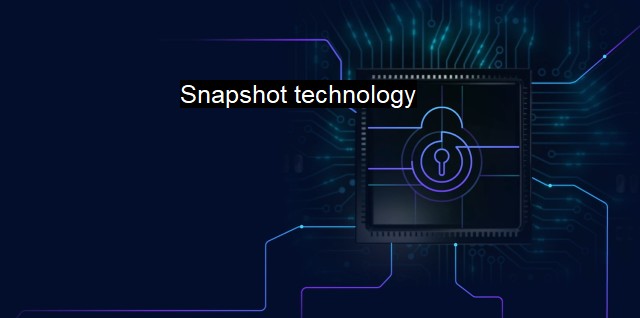What is Snapshot technology?
The Evolution of Data Protection in Cybersecurity: Exploring Snapshot Technology and its Role in Disaster Recovery
Snapshot technology is an innovative concept within the field of cybersecurity and antivirus protection. This technology serves as a valuable tool for establishing system reliability and ensuring data recoverability by providing a clear and robust representation of a computer system at a distinct point in time.At its core, snapshot technology creates a point-in-time copy of an entire data set, or simply specified parts. This snapshot operates by tracking the modifications to the system's data and saving a version of data for a point at which the snapshot was taken.
Snapshot technology plays an intrinsic role in backup and recovery strategies. Cybersecurity threats such as ransomware, phishing attacks, viruses, and other malware are continuously evolving, often bypassing the measures IT departments put in place to protect critical data. Snapshot technology mitigates these threats by elevating antivirus strategies, intrinsically providing an additional layer of security, ensuring that data can be easily restored following a cyber-attack.
Termed as an inherently efficacious method of antivirus protection, snapshot technology can revert to a snapshot taken before a virus infection, thereby restoring the system to its prior state. This acts as a safety net, enabling rapid recovery and minimizing downtime in the aftermath of a cyber-attack.
Snapshot technology not only supports recovery from catastrophic data loss emerging from cyber threats but also aids in mitigating issues arising from human error. Unwanted alterations, modifications, or potential deletions can all be overcome and data quickly restored with the help of this technology.
Coupling snapshot technology with traditional forms of backup protection enhances the robustness of a cybersecurity platform. It advances the notion of 'defense in depth', a key aspect of cybersecurity, where multiple layers of security controls are placed within an IT system. Traditional backups are more time-consuming, as they require files to be copied. Having instantaneous snapshots as frequent recovery points contributes to swift incident response, a facet that is crucial in the ever-changing and dynamic threat landscape.
Snapshot technology also offers notable assistance during system upgrades or software patches. Before the initiation of such changes, a snapshot can be created. If the upgrade or patch inadvertently causes problems or system instability, administrators can easily revert to the snapshot taken before these actions, allowing a quick and effective return to a safe and sound operational state.
As snapshot technology continues to advance and gain more adoption in digital environments, challenges such as snapshot management, storage consumption, and snapshot protection also arise. Administrators need to ensure snapshots do not consume excessive storage space and manage them effectively to avoid obsolete snapshots, thus causing unnecessary data clutter. They will also need to shield snapshots from cyber-attacks as cybercriminals can target and manipulate these stored entities consistent with their invasion strategies. Hence, protecting snapshots is as imperative as the data they embody.
Snapshot technology forms an integral part of the cybersecurity landscape, paired with antivirus protocols. They deliver computer systems with the capability to bounce back from catastrophic incidents rapidly, be it an aggressive cyber-attack, a faulty system upgrade, or an accidental deletion. By assembling a holistic and robust defense strategy encompassing snapshot technology, administrators can affirm resiliency, crisis mitigation, rapid recoverability, and continuous operational efficiency in today's highly digitized environments.

Snapshot technology FAQs
What is snapshot technology in cybersecurity?
Snapshot technology in cybersecurity is a feature used by some antivirus programs that allows the system to take a snapshot of a file or a section of the system at a specific time. This snapshot can then be used to compare with the current state of the system or file to identify changes or modifications.How does snapshot technology help in cybersecurity?
Snapshot technology helps in cybersecurity by allowing antivirus programs to detect and prevent malware attacks. When a malware attack occurs, the snapshot taken by the antivirus program can be compared with the current state of the system to identify any changes made by the malware. This way, the antivirus program can take appropriate measures to neutralize the threat.What are the benefits of using snapshot technology in antivirus programs?
The benefits of using snapshot technology in antivirus programs are as follows: 1. Provides real-time protection against malware attacks 2. Detects and prevents zero-day attacks 3. Enables faster and more accurate threat detection 4. Helps in identifying unusual modifications made to the system or files by malware 5. Enhances the overall security posture of the system.Are there any limitations of using snapshot technology in antivirus programs?
Yes, there are some limitations of using snapshot technology in antivirus programs. One of the major limitations is that it requires a significant amount of system resources, which can slow down the system's performance. Another limitation is that snapshots need to be taken frequently to ensure that the system's state is up-to-date, which can also impact system performance. Additionally, some malware attacks may be designed to evade detection by snapshot-based antivirus programs.| | A | | | B | | | C | | | D | | | E | | | F | | | G | | | H | | | I | | | J | | | K | | | L | | | M | |
| | N | | | O | | | P | | | Q | | | R | | | S | | | T | | | U | | | V | | | W | | | X | | | Y | | | Z | |
| | 1 | | | 2 | | | 3 | | | 4 | | | 7 | | | 8 | | |||||||